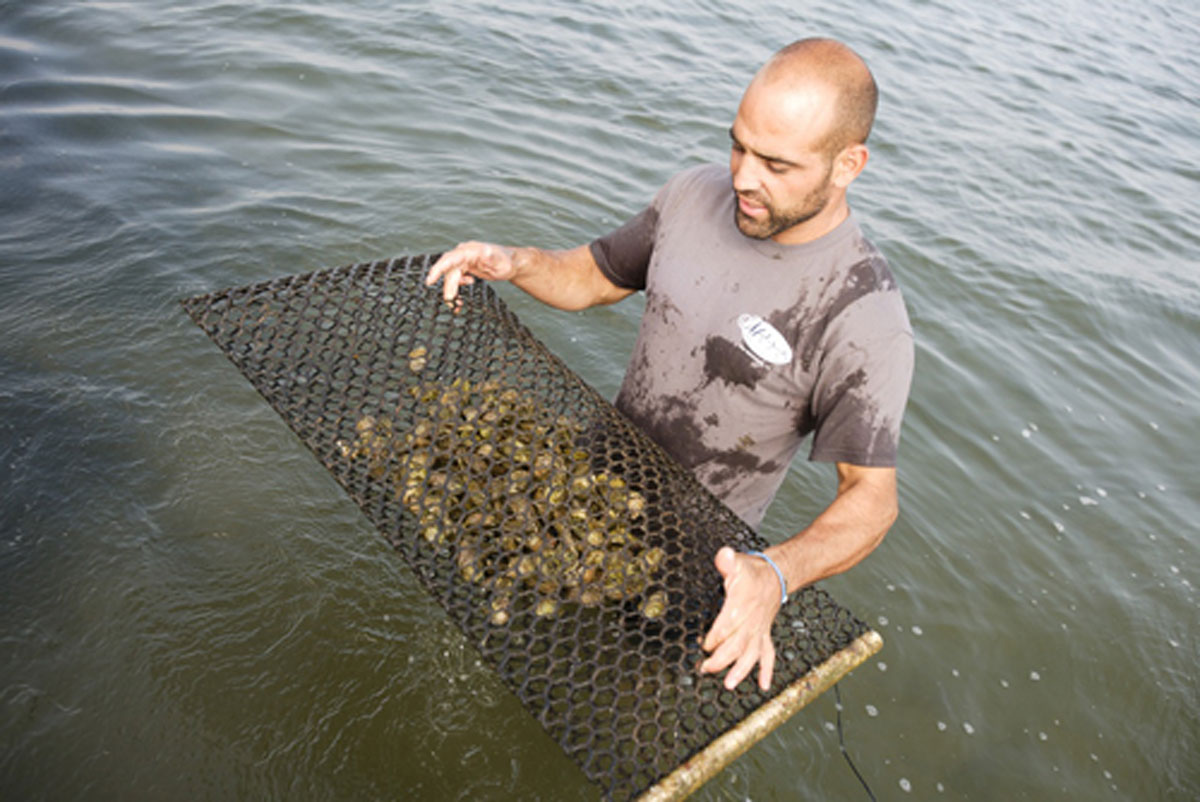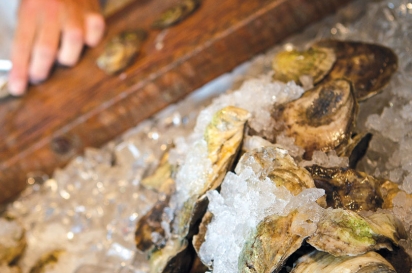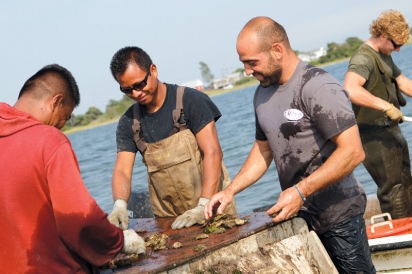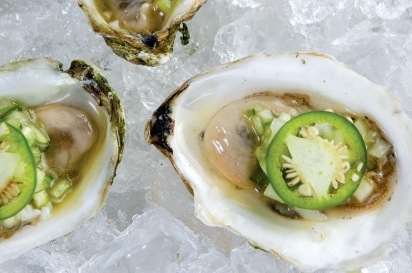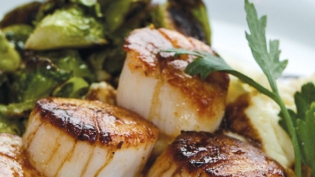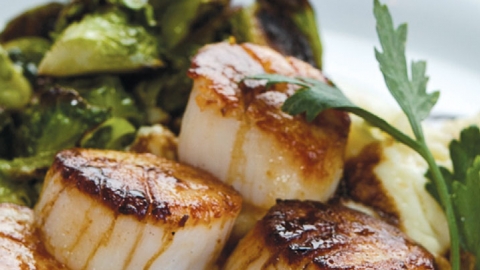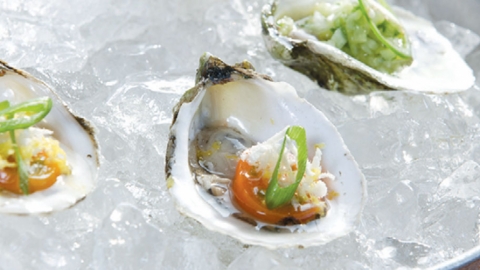Perry Raso and Matunuck Oyster Bar
“Oh, Oysters Come and Walk with Us!”
It’s a gray day on the water. Light fog veils the far end of Potter Pond. Egrets stalk the banks like tiptoeing burglars and squawking gulls wheel overhead. Perry Raso is walking among the oysters. He’s gone over the side of the boat and he’s wading around in three-foot-deep water so I can see how he farms. Reaching down into the water, he pulls up a long, black mesh bag, opens it and shows me the tiny, greenish shells inside. There are hundreds of them.
Perry’s Matunuck Oyster Farm consists of seven acres, arranged in rows just like a cornfield but underwater. The farm gets seed oysters, just post-larval, from a hatchery in Maine—little bitty things no bigger than a pinhead—and they go right into a nursery system called an upweller. There they grow in a carefully maintained, safe environment until they are big enough to face the real world out in the pond.
Sorted by size, as they will be for the rest of their lives, they go into bags like the one Perry just showed me. The bags are attached with bungee cords to PVC pipes laid out on the bottom of the pond, and there the baby oysters will reside, filtering water, adding more and more shell, like the rings in a tree, until after a year or two they reach market size. Perry estimates that there are currently around 20 million oysters on the farm—more than twice the population of New York City.
What makes a Matunuck oyster different from a Salt Pond or Cedar Point or, for that matter, a Bluepoint? Just as grapes grown on one side of a hill will yield a wine that tastes, smells and looks different than one from the same grapes grown on the other side of the hill, so its locality determines the way a fresh-shucked oyster will taste. Perry tells me that the word du jour to describe this quality is meroir.
Meroir is a term coined by Rowan Jacobsen, author of A Geography of Oysters, to describe, how “oysters exhibit their provenance so precisely. Terroir, after all, refers to terra firma, and oysters’ terra isn’t very firma.” Another useful phrase in any oyster-based conversation is “seston flux,” which quantifies the milligrams of food per liter of water in the oyster’s habitat. Seston flux—and the precise mix of nutrients it carries—is clearly a major determinant of the oyster’s particular meroir.
Once Perry’s oysters reach market size, you may find the mat farmers’ markets across the state. Perry and his crew now sell oysters, clams and lobsters at four markets every Saturday (Providence, Coastal Growers, Aquidneck and South Kingstown).The exposure he’s gotten at those markets has been a huge factor in the instant popularity of his next venture.
The Matunuck Oyster Bar is already entering its second year at a venue on Succotash Road that had hosted a string of not-so-successful dining spots. Perry opened there in 2009, just seven years after going into the oyster farming business. While his success at oystering proved that both his aquacultural and marketing skills were solid, he didn’t have much in the way of restaurant background.
“I was a busboy in a Chinese restaurant once,” he told me.
Until he was about 9, Perry lived in Long Island, karmically close to Oyster Bay. Then his family moved to Rhode Island. He started digging littlenecks at 13, and soon he was making $50 to $60 a day.
He went to college out West, but transferred back to the University of Rhode Island and ended up majoring in aquaculture and pathology science. After receiving a graduate degree (in aquaculture and fisheries tech) he taught school kids about aquaculture. In 2002 he leased his first 1.3 acres in Potter Pond and began developing the oyster farm. In 2006 he started selling his crop at Casey Farm in North Kingstown. There, Pat McNiff got him connected with other farmers’ markets around the state and Perry began to brand Matunuck Oysters.
The restaurant came about when the last tenant at the spot on Succotash Road folded. Perry was using the dock there to land oysters and he thought, “I’m going to invest in this place.” He added a deck overlooking the pond and began the pursuit of his vision: “simple food, fairly priced, fresh products, making sure everybody leaves happy.”
Simple vision, difficult execution.
Perry has handed management of the oyster farm off to David Lemus so that he can focus on the restaurant. I ask him if he was gratified by the oyster bar’s instant popularity.
“I’m never satisfied,” he says. “We still have so much to do. Customers have to wait outside for a table. The kitchen is too small for the volume we do. I try to visit every table when they’re finishing up, and even though the comments are usually positive, it bothers me if someone says the fried oysters were a little overcooked or the orders took too long to get to the table. I’ve hired a real professional manager, Robin McGowan, and he’s putting serious organization in.”
Now the Matunuck Oyster Bar serves 500–600 meals a day, and shucks 1,000 oysters, many of which made the very short trip from the Potter Pond farm to my plate while I was driving down from Providence. The two chefs—Wayne Bush and Thom Curtis—share the incredibly small kitchen, working different shifts and days, but the recipes are consistent and the food matches Perry’s vision.
When Perry hired chef Wayne, he asked him if he thought they could get the restaurant up and running in a month. “Honestly, I’m not sure it’s possible,” said Wayne.
“Honestly, we’re doing it,” replied Perry.
They opened in a month.
If you have a vision—your Platonic ideal of a New England waterside restaurant—you owe it to yourself to see how close Perry Raso is to fulfilling it. But get there early—a lot of people have already made it a prime destination.
629 Succotash Rd., East Matunuck 401-783-4203; www.rhodyoysters.com


